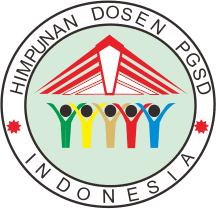Pengaruh model interactive-case based learning terhadap kemampuan berpikir kritis peserta didik kelas v pada pembelajaran ipa sekolah dasar
Abstract
Keywords
References
F. Z. Firdaus, S. Suryanti, and U. Azizah, “Pengembangan Multimedia Interaktif Berbasis Pendekatan SETS Untuk Meningkatkan Kemampuan Berpikir Kritis Siswa Sekolah Dasar,” J. Basicedu, vol. 4, no. 3, pp. 681–689, 2020, doi: 10.31004/basicedu.v4i3.417. [2] E. Susanti, M. Taufiq, M. T. Hidayat, and Machmudah, “KEMAMPUAN BERPIKIR KRITIS SISWA SDN MARGOREJO VI SURABAYA MELALUI MODEL JIGSAW Student's Critical Thinking Skills of Margorejo VI Surabaya Elementary School Through Jigsaw Model,” Bioedusiana, vol. 4, no. 1, pp. 55–64, 2019, doi: 10.34289/bioed.v4i01.792. [3] M. Khishaaluhussaniyyati, N. Faiziyah, and C. K. Sari, “Analisis Kemampuan Berpikir Kritis Siswa Kelas 10 SMK dalam Menyelesaikan Soal HOTS Materi Barisan dan Deret Aritmetika Ditinjau dari Self Regulated Learning,” J. Cendekia J. Pendidik. Mat., vol. 7, no. 1, pp. 905–923, 2023, doi: 10.31004/cendekia.v7i1.2170. [4] F. Fetricia, H. Soekamto, D. Soelistijo, and D. H. Utomo, “Model Problem Based Learning berbantuan video berita: Pengaruhnya terhadap kemampuan berpikir kritis pada siswa SMA,” J. Integr. dan Harmon. Inov. Ilmu-Ilmu Sos., vol. 3, no. 7, pp. 741–752, 2023, doi: 10.17977/um063v3i7p741-752. [5] S. Febriyanti, V. Istihapsari, and D. Afriady, “Pbl Keaktifan Hasil Belajar - Siti,” pp. 1283–1292, 2021. [6] M. R. H. Marudut, I. G. Bachtiar, Kadir, and V. Iasha, “Peningkatan Kemampuan Berpikir Kritis Dalam Pembelajaran IPA,” J. BASICEDU Res. Learn. Educ., vol. 4, no. 3, pp. 577–585, 2020. [7] M. FAJAR, “Peranan Intelegensi Terhadap Perkembangan Keterampilan Fisik Motorik Peserta Didik Dalam Pendidikan Jasmani,” Multilateral. J. Pendidik. Jasm. dan Olahraga, vol. 16, no. 1, pp. 58–66, 2017, doi: 10.20527/multilateral.v16i1.3664. [8] F. M. Kinanti and N. Anas, “Efektivitas Penggunaan Alat Peraga ‘Aliran Darahku’ Terhadap Kemampuan Berpikir Kritis Materi Sistem Peredaran Darah,” Edukasi J. Pendidik., vol. 22, no. 1, pp. 87–101, 2024, doi: 10.31571/edukasi.v22i1.7315. [9] R. W. Purnomo, “Pengaruh Kreativitas Guru Terhadap Berpikir Kritis Peserta Didik SMP Se Kecamatan Gresik,” no. 2018, pp. 43–58, 2020, [Online]. Available: http://eprints.umg.ac.id/4025/ [10] Ramlawati, S. R. Yunus, and A. Insani, “Pengaruh Model PBL (Problem Based Learning) terhadap Motivasi dan Hasil Belajar IPA Peserta Didik,” J. Sainsmart, vol. 6, no. 1, pp. 1–14, 2017, [Online]. Available: http://ojs.unm.ac.id/sainsmat/article/download/6451/3684 [11] Z. Linda and I. Lestari, Berpikir Kritis Dalam Konteks Pembelajaran, no. August. 2019. [12] J. Funke, “Problemlösendes Denken [Problem solving thinking],” no. January 2003, 2003, [Online]. Available: https://www.researchgate.net/publication/262179219 [13] J. Frensch, Peter A., Funke, P. A. Frensch, and J. Funke, “Complex Problem Solving The European Perspective,” Complex Probl. Solving, no. September, p. 358, 2014, [Online]. Available: https://bit.ly/3qzCCvD [14] R. Miftah, J. A. Dahlan, L. Kurniawati, and T. Herman, “How does interactive case-based learning improve students ’ complex mathematical problem-solving abilities ?,” vol. 7, no. August, pp. 307–326, 2024. [15] R. Miftah, L. Kurniawati, and K. F. Musa, “Development of Prospective Teacher Student Worksheets Through Interactive Case-Based Learning Model Assisted by Cublend App to Improve Mathematical Literacy Skills,” Math. Teaching-Research J., vol. 16, no. 4, pp. 76–93, 2024.
Refbacks
- There are currently no refbacks.



